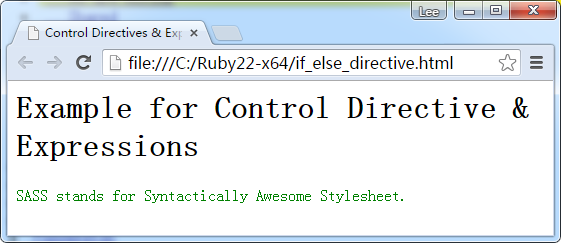Sass @else if指令
@else if語句用來與@if指令一起使用。當 @if 語句失敗時,則 @else if 語句測試,如果它們也無法測試滿足時再 @else 執行。
語法
@if expression {
// CSS codes
} @else if condition {
// CSS codes
} @else {
// CSS codes
}
範例
下面的例子演示了如何使用@else if 指令:
<html>
<head><meta charset="utf-8"> <title>Control Directives & Expressions</title>
<link rel="stylesheet" type="text/css" href="style.css"/>
</head>
<body>
<div class="container">
<h1>Example for Control Directive & Expressions</h1>
<p>SASS stands for Syntactically Awesome Stylesheet.</p>
</div>
</body>
</html>
接下來,建立檔案 style.scss。
style.scss
$type: audi;
p {
@if $type == benz {
color: red;
} @else if $type == mahindra {
color: blue;
} @else if $type == audi {
color: green;
} @else {
color: black;
}
}
可以告訴SASS監視檔案,並隨時使用下面的命令更新SASS檔案修改CSS:
sass --watch C:\Ruby22-x64\style.scss:style.css
接著執行上面的命令,它會自動建立 style.css 檔案,如下面的程式碼:
style.css
p {
color: green; }
輸出結果
讓我們來執行以下步驟,看看上面的程式碼工作:
儲存上面的 html 程式碼在 if_else_directive.html 檔案。在瀏覽器中開啟該HTML檔案,輸出如下得到顯示。

